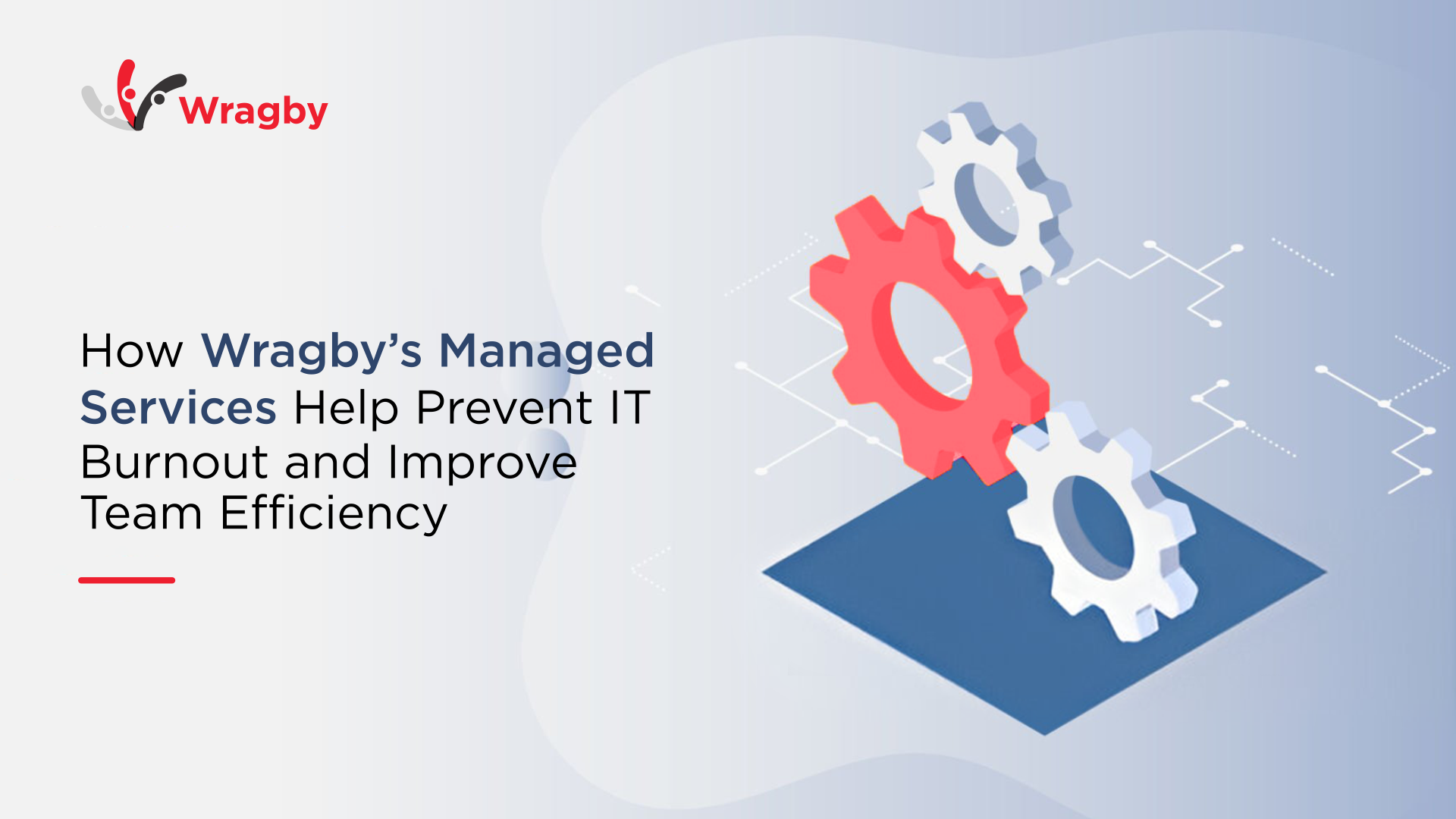
How Wragby’s Managed Services Help Prevent IT Burnout and Improve Team Efficiency
Understanding IT Burnout: Causes and Warning Signs
You have probably seen it, maybe even felt it yourself. That slow, creeping exhaustion that no amount of coffee can fix. Your IT team isn’t lazy. They’re just tired. Really tired.
They are juggling too many tasks at once: patching systems after hours, responding to user complaints in real time, managing legacy infrastructure that’s barely holding on, all while trying to keep up with the latest security threats and tech updates.
What starts off as a few late nights quickly snowballs into burnout:
• Snappy responses in meetings
• Missed deadlines
• A drop in creative problem-solving
• Silence on the group chat where there used to be jokes
It’s not just about being busy. It’s the kind of mental and emotional fatigue that builds when your team is always putting out fires and never has the time or energy to look ahead.
The scary part? Burnout doesn’t announce itself. It creeps in quietly and becomes part of the culture. And before you know it, your best people are either checked out or walking out.
This is where many businesses start to feel the real cost, not just in downtime, but in human capital. The good news? It doesn’t have to be this way.
The Hidden Cost of Burnout on Your Business
It’s easy to dismiss burnout as a personal issue, something your team just needs to “push through.” But the truth is, burnout doesn’t just affect people. It affects your business. Quietly. Constantly. Expensively.
When your IT team is burnt out, things start slipping through the cracks:
• Tickets take longer to resolve
• Backups aren’t double-checked
• Security updates get postponed
And when systems fail or cyberattacks happen, the damage multiplies. One tired decision can lead to hours of downtime, lost revenue, and frustrated customers.
But that’s just the surface. The deeper cost?
Your team starts to disengage. The once-motivated tech lead begins doing the bare minimum. A sharp junior engineer hands in their resignation, and now you’re spending weeks, maybe months, trying to hire and train a replacement in a competitive market.
“According to a Gallup report, burned-out employees are 63% more likely to take a sick day and 2.6 times more likely to actively seek a different job. For IT departments, this kind of turnover can break continuity and disrupt your most critical operations.“
You didn’t hire smart people to be stuck in survival mode.
The real question isn’t “Can they handle it?”
It’s “Should they have to?”
Why Traditional IT Management Isn’t Enough
For many companies, the IT setup hasn’t changed in years.
The same team.
The same stretched-thin infrastructure.
The same cycle: fix, patch, repeat.
It worked fine when the business was smaller, when users were fewer, when cyberthreats were rare. But now?
The demands have multiplied, and the tools haven’t.
Traditional IT management relies heavily on a small internal team to handle everything: security, support tickets, hardware, network uptime, software updates, and more. And when one thing breaks, everything else is paused to fix it.
It’s reactive, not proactive. And in today’s digital environment, that’s a risky way to operate.
Worse still, IT professionals are often treated like firefighters, only called upon when something’s burning. They’re expected to be everywhere at once, responding to users, battling system issues, planning upgrades (if there’s time).
It’s unsustainable. And the toll isn’t just stress. It’s lost innovation.
Think about it.
When your IT team spends all day putting out fires, who’s building the future? Who’s thinking strategically about how technology can actually grow your business?
Here’s the hard truth. Your team doesn’t need more pressure.
They need better support.
And that starts with rethinking how IT is managed.
What Are Managed IT Services (And Why They Matter Today)?
Imagine if your IT team didn’t have to do it all alone.
Imagine if they could stop firefighting and start actually building.
That’s what Managed IT Services are all about, giving your internal team the breathing room they need by outsourcing the heavy lifting to experts who live and breathe infrastructure, security, and performance.
But it’s not just outsourcing. It’s partnership.
A Managed Services Provider (MSP) steps in to handle the day-to-day operations of your IT environment:
• Monitoring systems 24/7
• Handling updates and patches
• Managing cybersecurity threats
• Backing up data
• Troubleshooting problems before they affect users
It’s like having a second IT team working in the background, constantly watching, tuning, and protecting so your in-house team can focus on higher-impact projects.
And here’s the best part. It’s scalable.
Whether you’re a mid-sized business trying to stabilize or an enterprise going through digital transformation, managed services can adapt to your pace.
In a world where downtime is expensive and skilled IT talent is hard to find, managed IT services aren’t just helpful. They’re strategic.
They don’t replace your internal team.
They empower them.
How Managed Services Help Prevent Burnout
Burnout doesn’t happen overnight.
It creeps in when small stressors pile up. When late-night calls become routine, when security updates keep getting bumped, when one person is holding five systems together with sheer will.
That’s where Managed Services make a real difference.
By offloading routine maintenance, updates, and monitoring to a dedicated provider, your in-house team gets the most underrated gift in IT: headspace.
No more reactive chaos. No more urgent escalations because someone forgot to install a patch. No more sleepless nights hoping the servers don’t go down.
Instead, your team gets:
• Time to plan strategically
• Room to focus on business growth initiatives
• Confidence that the backend is being handled by a partner who’s always watching
It’s not about doing less. It’s about doing the right things and knowing someone else is holding the line.
The result?
Your team works smarter, not harder.
They feel supported, not stranded.
And burnout? It starts to fade.
Real-World Signs Your IT Team Needs Support
Sometimes, burnout doesn’t look like someone collapsing at their desk.
It looks like quiet frustration. Missed details. The sparkle fading from someone who used to love solving problems.
Here are the red flags to watch for in your IT team:
• Slower response times. Projects drag. Tickets pile up. Urgency fades because the team’s fuel tank is empty.
• Increased errors. Overloaded minds miss small but critical details. Backups fail. Patches are skipped. Risks go unnoticed.
• High turnover or absenteeism. When burnout peaks, people leave, or check out mentally while still on the job.
• Lack of innovation. Your IT team used to bring fresh ideas to the table. Now, it’s all about getting through the day.
• Rising downtime or recurring issues. Without time to address root causes, problems keep coming back.
Maybe your team hasn’t said it outright, but if these signs are showing up, they’re waving a flag.
The good news? You don’t have to wait for a breakdown to act.
You can step in with support. You can change the rhythm. You can say, “We see you, and we’ve got help.”
Wragby’s Managed Services – The Support Your IT Team Deserves
At Wragby, we’ve worked with businesses across industries, from fast-growing startups to large enterprises. And we’ve seen one truth play out over and over again.
Your IT team is the backbone of your business.
But they can’t carry everything alone.
That’s why our Managed Services are built to do more than just keep the lights on.
We become an extension of your team, handling the routine, the complex, and the unexpected. Whether it’s 24/7 system monitoring, infrastructure optimization, security management, or cloud performance tuning, we’re there. Behind the scenes. Always on.
Here’s what partnering with Wragby looks like:
• Reduced pressure on your internal team
• Improved uptime and faster incident response
• Scalable support tailored to your growth
• Proactive cybersecurity and compliance checks
• More time for your team to focus on innovation, not just survival
You don’t have to burn out your best people to stay competitive.
You don’t have to choose between growth and stability.
With the right support, you can have both.
Let’s help your team breathe again and build what’s next, together.



Leave a Reply